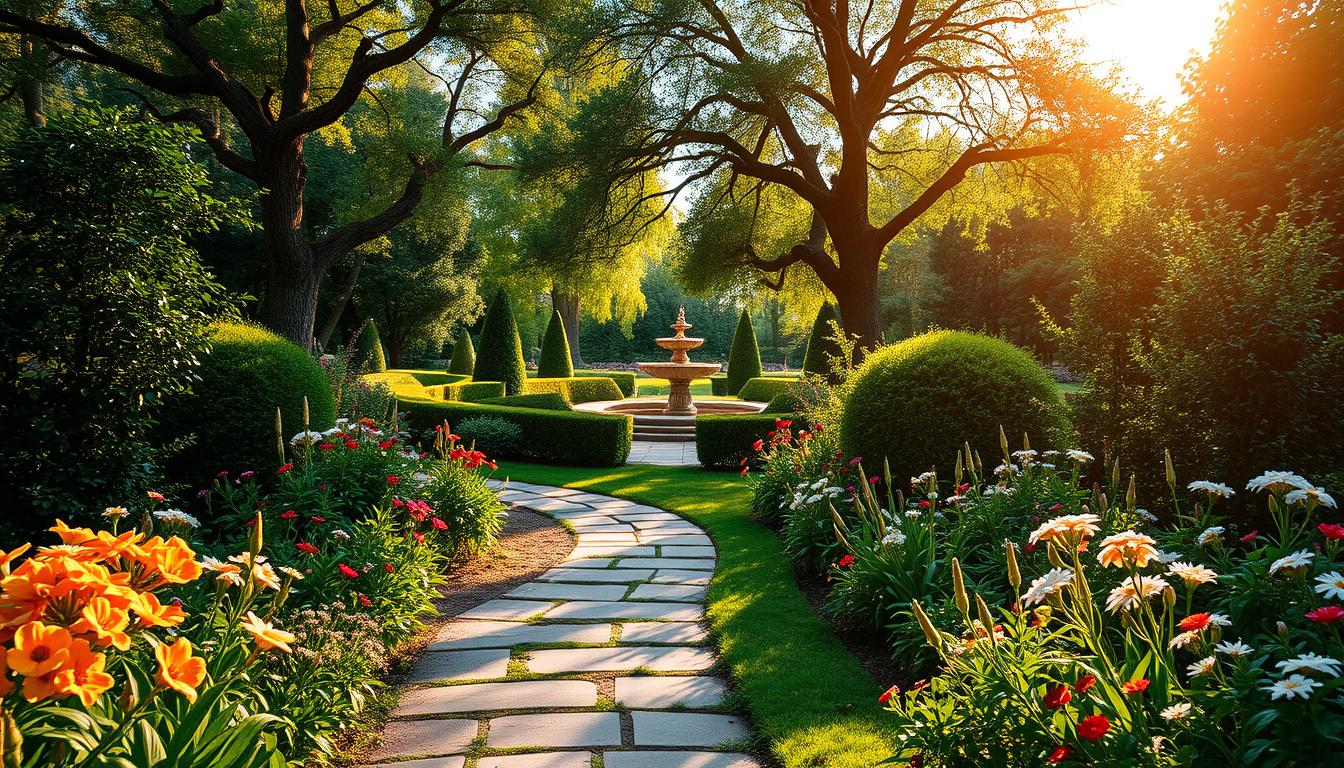Creating a stunning outdoor space is about more than just planting flowers. It’s about crafting an environment that feels inviting and functional. Whether you’re dreaming of a woodland path or a kitchen garden, intentional design can make all the difference.
Trending approaches like layered planting and destination points are gaining popularity. These methods not only enhance beauty but also create a sense of movement and purpose. By integrating these principles, you can turn any area into a personal retreat.
Good design also boosts property value and enjoyment. Even with challenges like limited space or wildlife, practical solutions exist. With the right planning, your garden can become a place of joy and relaxation.
Key Takeaways
- Intentional design transforms spaces into functional and beautiful areas.
- Trending approaches include woodland paths and kitchen gardens.
- Core principles like movement and destination points enhance layouts.
- Good design increases property value and personal enjoyment.
- Practical solutions address common challenges like limited space.
Introduction to Outdoor Garden Designs
Strategic layouts and plant choices can elevate your yard’s appeal. By following a few key principles, you can create a space that feels both functional and beautiful. Let’s explore some ideas to transform your area into a personal retreat.
One of the golden rules is to create movement with curved paths. This not only adds visual interest but also guides visitors through the space. Another tip is to bring planting into every corner. A balanced ratio of 50% plants and 50% hardscaping can make even small areas feel expansive.

Color psychology plays a big role in design. Cool tones like blues and greens can make a space feel larger, while warm colors like reds and yellows create intimacy. Use these shades to enhance the mood of your yard.
For those with limited space, vertical gardening is a game-changer. Hanging planters and climbing vegetables maximize vertical areas without sacrificing style. Budget-friendly options, such as gravel instead of lawn, also offer practical and aesthetic benefits.
Finally, consider wildlife-friendly approaches. A pollinator garden not only supports local ecosystems but also adds vibrant life to your space. For more tips on starting your project, check out this beginner’s guide.
1. Woodland Path Garden Plan
Transform your space with a woodland-inspired walkway. This design brings a natural, serene feel to any area. By using curved pathways, you can create a sense of discovery and movement.
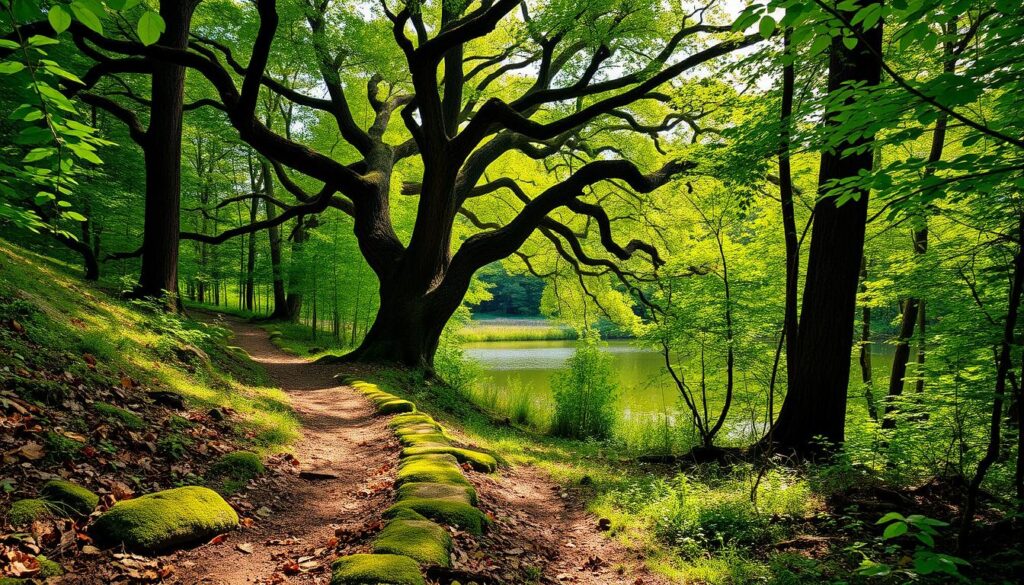
Incorporate native ferns and shade-loving plants to enhance the natural aesthetic. These choices thrive under trees and add lush greenery to the ground. For clean, defined edges, Scott Zimmer’s metal edging technique prevents grass from encroaching on your path.
Creating a Natural Walkway
Companion plants like hostas and astilbes add layered texture to your walkway. Their varied heights and colors create visual interest. Pair them with bark mulch for moisture retention and a cohesive look.
Here’s a quick guide to plant combinations for your woodland path:
| Plant | Benefits |
|---|---|
| Hostas | Adds lush foliage and thrives in shade. |
| Astilbes | Provides vibrant color and texture. |
| Native Ferns | Enhances the natural woodland feel. |
With these tips, your woodland path will become a beautiful, functional addition to your space. It’s a simple way to bring nature closer to home.
2. Bark-Appeal Garden Plan
Winter doesn’t have to mean dull; it can be a season of vibrant beauty. The Bark-Appeal Garden Plan focuses on plants with unique textures and colors that shine even in colder months. By incorporating peeling bark and evergreen elements, you can create a space that looks stunning all year.
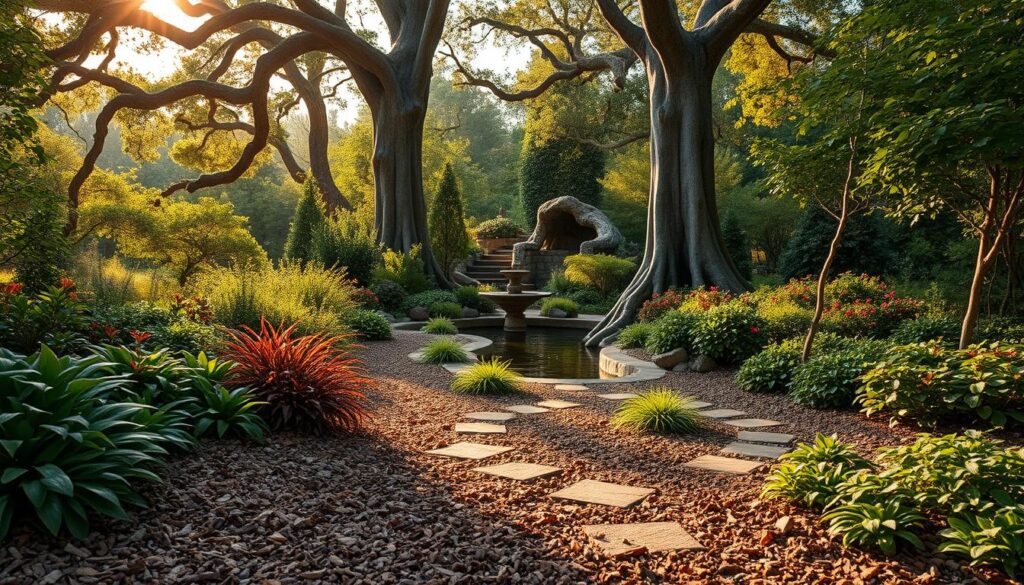
One standout choice is the paperbark maple (Acer griseum). Its cinnamon-colored exfoliating bark adds warmth and texture to your garden bed. Another excellent option is the redtwig dogwood (Cornus sericea). Its vibrant red stems pop against the winter snow, creating a striking contrast.
Adding Winter Interest
Birch species with white bark are perfect for adding a clean, bright look. Pair them with evergreen shrubs for a balanced and cohesive design. Ornamental grasses left standing through winter also add movement and texture to your space.
For ground-level interest, consider creeping juniper. This evergreen groundcover provides winter color and helps tie the whole design together. By combining these elements, your space will remain lively and inviting, even in the coldest months of the year.
3. Deer-Resistant Garden Plan
Protecting your yard from deer doesn’t mean sacrificing beauty. By choosing the right plants, you can create a space that’s both stunning and deer-proof. Deer tend to avoid certain textures and scents, making it easier to design a plan that works.
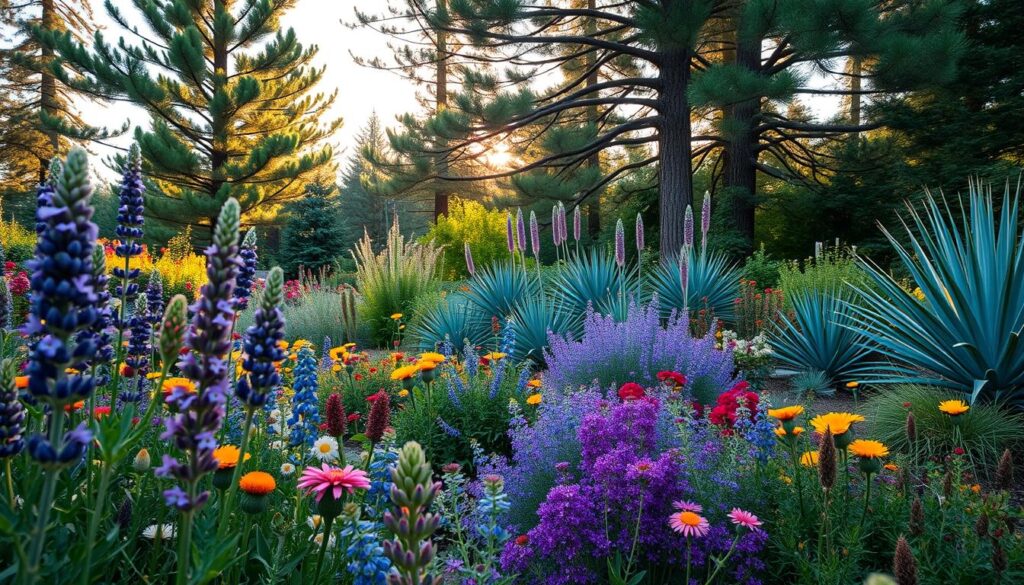
Choosing the Right Plants
Start with fuzzy-leaved options like lamb’s ear (Stachys byzantina). Its soft texture is unappealing to deer. Aromatic herbs like lavender and rosemary also act as natural deterrents. Their strong scents keep deer at bay while adding fragrance to your space.
For a spiky addition, consider sea holly (Eryngium). Its unique shape and texture make it a deer-resistant favorite. Ornamental grasses like Miscanthus are another great choice. Their sharp edges and tall growth create a natural fence that deer avoid.
Don’t forget bulbs like daffodils and fritillaria. These vibrant blooms are not only beautiful but also deer-resistant. By combining these plants, you can create a lush, untouched space that thrives all year.
4. Pollinator Garden
Bringing life to your space with a pollinator-friendly plan is easier than you think. By choosing the right flowers and plants, you can create a vibrant ecosystem that supports local wildlife. This approach not only beautifies your area but also contributes to the health of the environment.
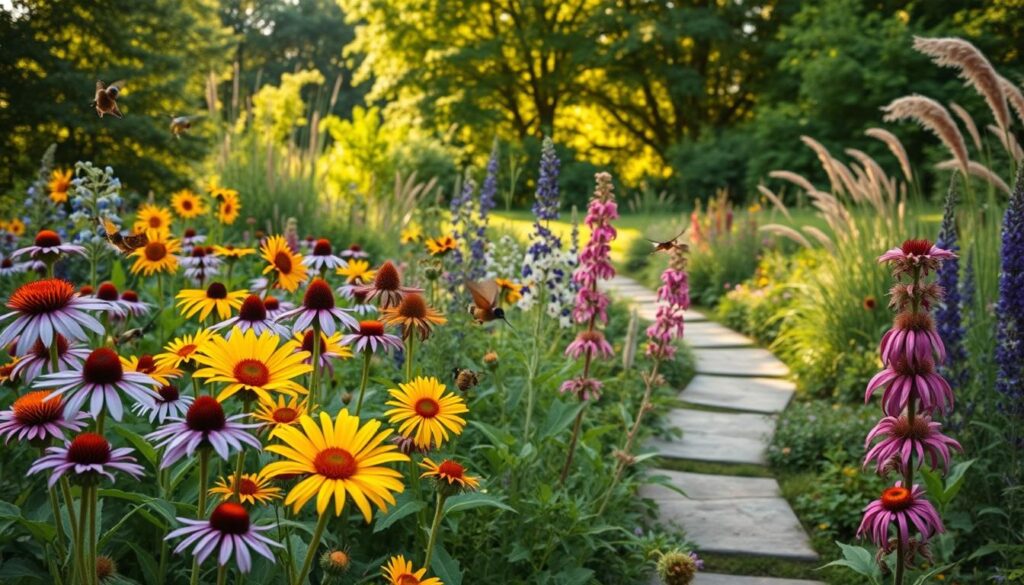
Start by planting native milkweed species. These are essential for monarch butterflies, providing both food and habitat. Tubular flowers like bee balm are perfect for attracting hummingbirds. Their bright colors and nectar-rich blooms are irresistible to these tiny visitors.
Supporting Local Wildlife
To keep pollinators active throughout the summer, stagger bloom times from spring to fall. Purple coneflower and black-eyed Susan are excellent choices. They offer long-lasting blooms and are favorites among bees and butterflies.
Don’t forget to add nesting sites. Bee hotels and undisturbed ground areas provide safe spaces for pollinators to thrive. By combining these elements, you’ll create a way to support wildlife while enjoying a lively, colorful space.
5. Ultimate Kitchen Garden Plan
Transform your patio into a functional and beautiful space with a kitchen garden. Jon Carloftis’ layout emphasizes edible aesthetics, blending practicality with visual appeal. This approach ensures your area is both productive and inviting.
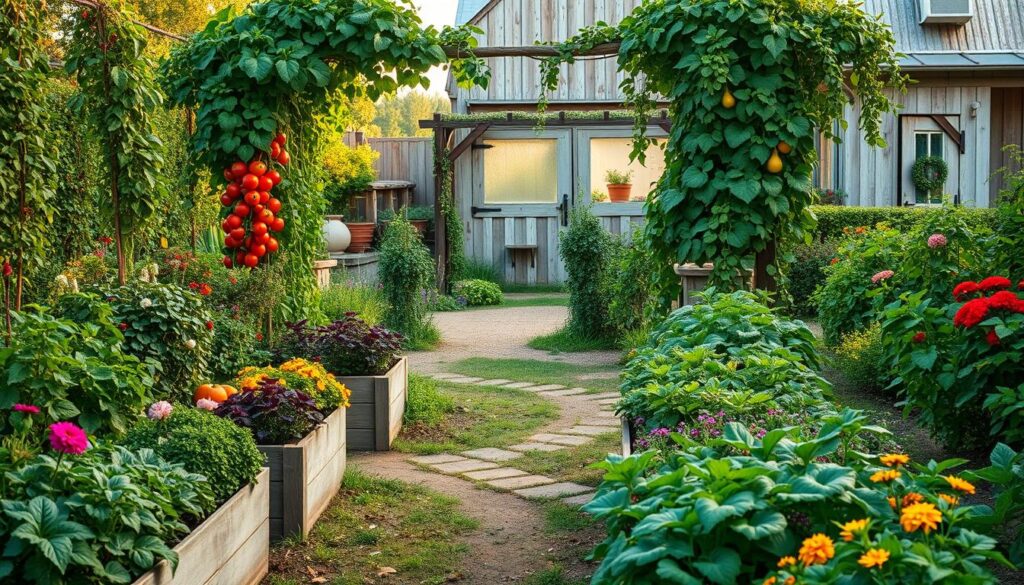
Start by incorporating geometric patterns with boxwood edging. This adds structure and elegance to your design. Interplant marigolds for pest control and a pop of color. Their bright blooms contrast beautifully with green foliage.
Combining Beauty and Functionality
Use vertical trellises for climbing beans and cucumbers. This maximizes your space while adding height and interest. Colorful Swiss chard varieties are excellent ornamental edibles. Their vibrant stems and leaves enhance the visual appeal of your layout.
For a dual-purpose design, consider dwarf fruit trees in containers. They provide fresh produce and serve as focal points. Here’s a quick guide to plant combinations for your kitchen garden:
| Plant | Benefits |
|---|---|
| Marigolds | Pest control and color contrast. |
| Swiss Chard | Ornamental and edible. |
| Dwarf Fruit Trees | Dual-purpose design. |
With these tips, your kitchen garden will be a stunning and productive addition to your home. It’s a perfect way to enjoy fresh herbs and vegetables while enhancing your space.
6. Wildflower Garden
A wildflower meadow brings effortless charm to any space. These vibrant flowers create a naturalistic look that’s both beautiful and low-maintenance. By using regional wildflower mixes, you can support local ecosystems while adding color to your ground.
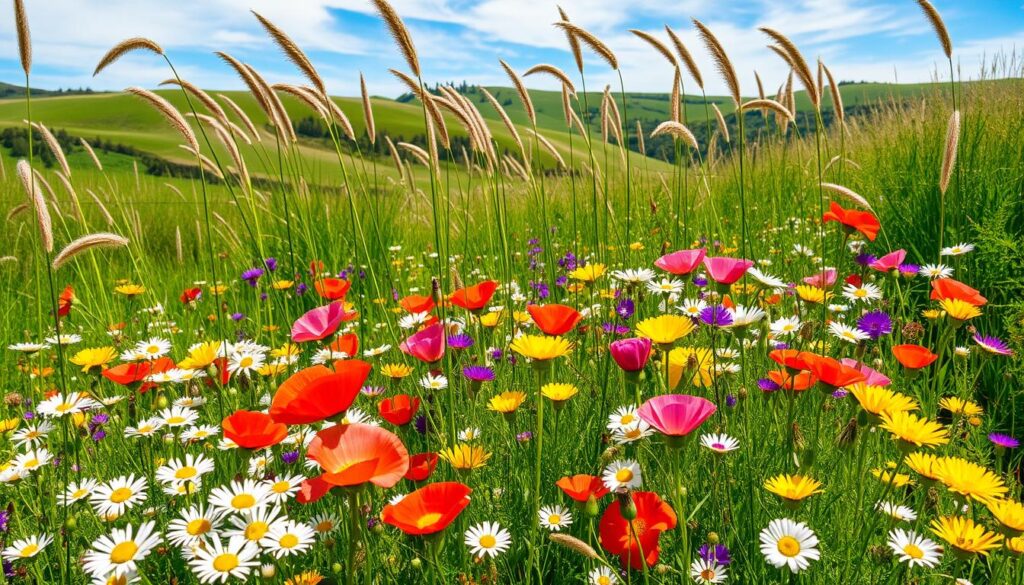
Create drifts of color with species like coreopsis and blanket flower. These plants bloom throughout the spring and summer, attracting pollinators and adding life to your space. For winter interest, leave seedheads standing to provide food for birds.
Embracing Naturalistic Beauty
Incorporate native grasses like little bluestem for movement and texture. These grasses sway in the breeze, adding a dynamic element to your meadow. For accessibility, mow paths through the area. This way, you can enjoy the beauty up close without disturbing the plants.
Here’s a quick guide to creating your wildflower meadow:
- Use regional wildflower mixes for ecological benefits.
- Plant coreopsis and blanket flower for vibrant color.
- Leave seedheads standing for winter bird food.
- Add native grasses like little bluestem for movement.
- Mow paths for easy access and enjoyment.
With these tips, your wildflower meadow will become a lively and sustainable addition to your space. It’s a simple yet impactful way to bring nature closer to home.
7. Perennial Cutting Garden Plan
Designing a perennial cutting space lets you enjoy fresh bouquets all year. By carefully selecting plants that bloom at different times, you can ensure a steady supply of vibrant flowers. This approach not only adds beauty to your space but also provides a practical way to create stunning arrangements.
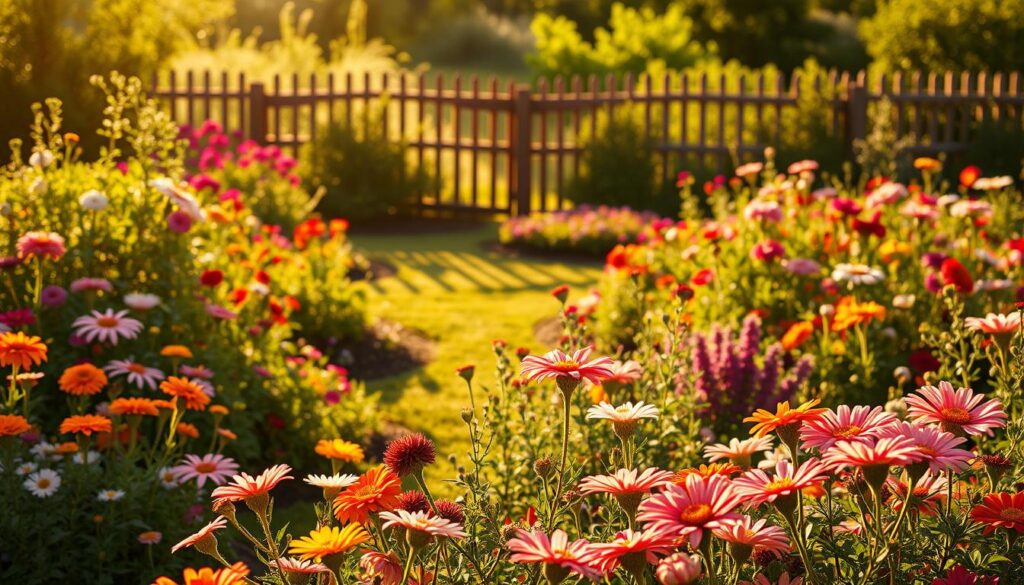
Start with long-bloomers like Erysimum ‘Bowles’s Mauve’. These plants provide color throughout the season, making them a reliable choice for your garden bed. Pair them with staggered bloomers like peonies, phlox, and dahlias to keep your space lively from spring to fall.
Growing Your Own Bouquets
Include filler plants like baby’s breath and feverfew. These delicate additions add texture and volume to your arrangements. Airy perennials like Verbena bonariensis also work well, creating a light, airy feel in your bouquets.
For a touch of elegance, add rose varieties with a long vase life. Their timeless beauty makes them a favorite for cutting. Fragrant options like stock and sweet peas bring both scent and charm to your floral creations.
Here’s a quick guide to plant combinations for your cutting space:
| Plant | Benefits |
|---|---|
| Erysimum ‘Bowles’s Mauve’ | Long-blooming and reliable. |
| Peonies | Large, showy blooms. |
| Verbena bonariensis | Adds airy texture. |
| Roses | Long vase life and elegance. |
| Sweet Peas | Fragrant and charming. |
With these tips, your perennial cutting space will become a source of joy and creativity. It’s a simple way to bring nature’s beauty indoors while enhancing your outdoor area.
8. Herb Garden
Growing fresh herbs at home is both practical and rewarding. Whether you have a spacious patio or a tiny balcony, there’s always room for a herb garden. With the right approach, you can enjoy fresh flavors all year round.
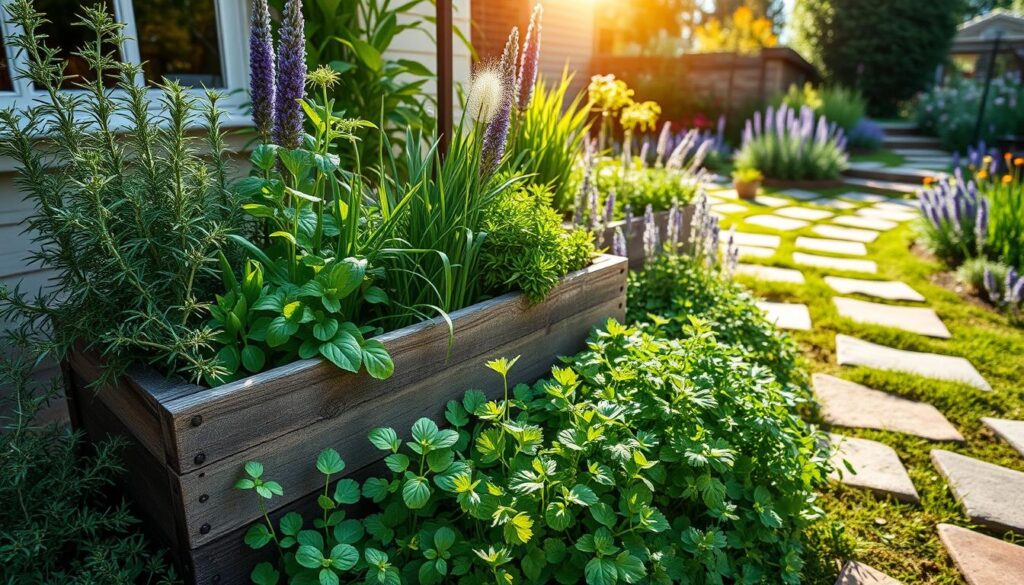
Growing Herbs in Limited Space
Vertical herb walls are a game-changer for small areas. Use tiered planters to grow thyme, oregano, and marjoram. These compact setups maximize your space while keeping herbs within easy reach.
Window boxes are another great option. They’re perfect for quick-access cooking herbs like basil and parsley. Place them near your kitchen for convenience and style.
Preserve your extras by drying or freezing them in olive oil. This ensures you always have fresh flavors on hand. Perennial herbs like sage and rosemary are low-maintenance and thrive year after year.
For a pop of color, add edible flowers like nasturtiums and borage. They’re not only beautiful but also enhance your dishes. With these tips, your herb garden will be both functional and delightful.
9. Cottage Garden
A cottage-style space brings timeless charm to any area. This approach combines flowering shrubs and old-fashioned annuals to create a picturesque scene. The result is a lively and inviting atmosphere that feels like a countryside retreat.

Start by planting climbing roses over arbors. Their fragrant blooms add vertical interest and a romantic touch. Mix hollyhocks and delphiniums for bold, colorful accents that draw the eye upward.
Creating a Charming Display
Include self-seeding annuals like cosmos and poppies. These flowers effortlessly fill gaps and create a natural, carefree look. Use picket fences as supports for sweet peas, adding a whimsical element to your space.
For a finishing touch, incorporate vintage elements like weathered urns or rustic benches. These details enhance the cottage aesthetic and provide a cozy way to enjoy your area. With these tips, your space will bloom with beauty all summer long.
10. Vertical Garden
Maximizing your vertical space can completely transform your area. Whether you have a small patio or a blank wall, vertical gardening offers a creative solution. It’s a practical and stylish way to add greenery without sacrificing floor space.
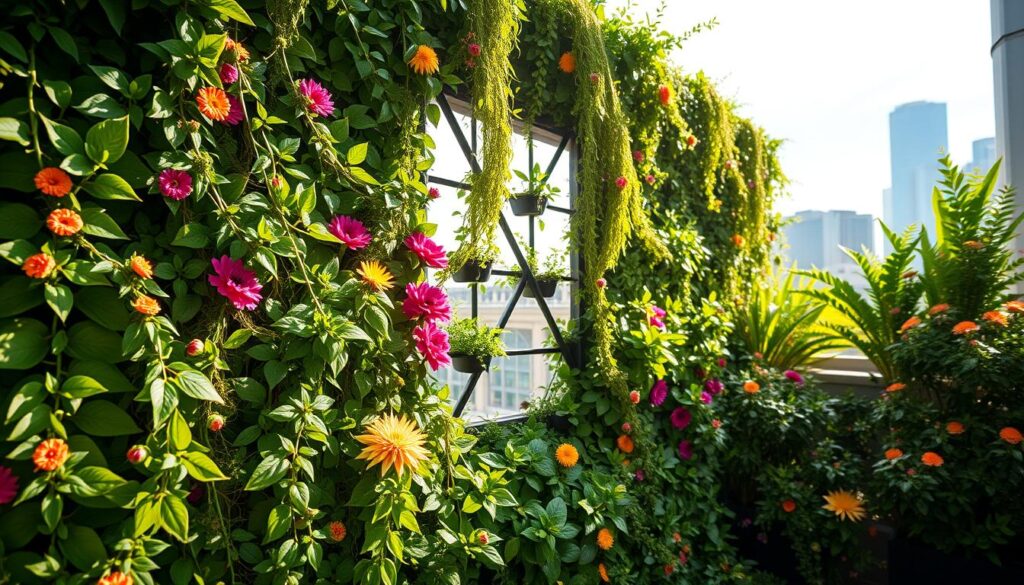
Start by installing modular living wall systems. These setups are easy to maintain and perfect for growing herbs, flowers, or even vegetables. Repurposing materials like pallets can also add a rustic touch. Use them as strawberry planters or to create a unique focal point.
Maximizing Vertical Space
Train climbing plants like clematis on obelisks for added height. This creates a stunning visual effect while maximizing your area. Hanging baskets are another great option. Fill them with trailing tomatoes or colorful flowers for a vibrant display.
For shaded areas, consider shade-tolerant ferns. They thrive on north-facing walls and add a lush, green backdrop. By combining these ideas, you can create a vertical garden that’s both functional and beautiful.
11. Raised Bed Garden Plan
A raised bed garden offers a smart solution for growing fresh produce in limited areas. Whether you’re working with poor soil or a small space, this approach maximizes your growing potential. With the right plan, you can cultivate a thriving area full of vegetables and herbs.

Building a Productive Garden
Start by constructing your bed using cedar boards. This material is durable, resistant to rot, and perfect for long-term use. Once your frame is ready, fill it with nutrient-rich soil to give your plants a healthy foundation.
Implement square foot gardening techniques to optimize space. This method divides your bed into sections, allowing you to grow more in less area. For example, plant one tomato per square foot or group smaller herbs like basil and thyme together.
Rotate crops annually to prevent disease and maintain soil health. Moving plants to different sections each year reduces the risk of pests and nutrient depletion. Adding trellises for climbing plants like beans or cucumbers also maximizes vertical space.
For natural pest control, mix flowers like calendula into your layout. These vibrant blooms repel unwanted insects while adding beauty to your ground. With these tips, your raised bed garden will be both productive and visually appealing.
Conclusion
Your yard can become a personal retreat with thoughtful planning and creativity. Whether you’re working with a small patio or a spacious area, the principles of intentional design can transform any space. Start small with container plants or a vertical setup to build confidence and see quick results.
Adaptability is key. From woodland paths to kitchen gardens, each style offers unique benefits. These designs not only enhance beauty but also increase property value over time. By incorporating native species and pollinator-friendly choices, you can support local ecosystems while enjoying a vibrant outdoor space.
Don’t wait to begin. Even a single raised bed or a few potted herbs can make a difference. Your garden will grow with you, offering joy and relaxation for years to come. Start today and watch your vision come to life.

